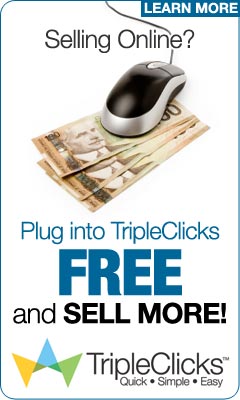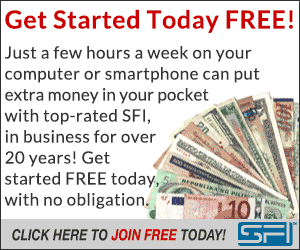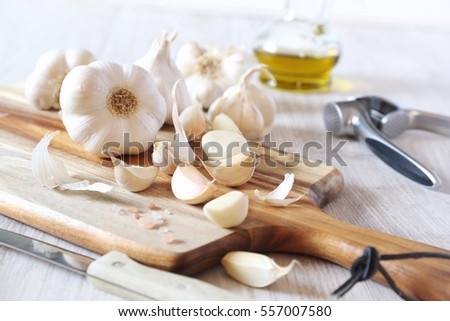Garlic is planted in the fall and harvested the following summer. The featured video might confuse you if you live in the U.S. or Europe, because it mentions planting in what we would consider summer months and harvesting in the middle of winter. This is because the film is based in Australia, where the seasons are transposed, and the shortest day of the year is June 21.

Here are some general planting guidelines to consider:
For the biggest bulbs, plant your cloves in the fall after the first frost. If you don't mind smaller bulbs, you can also plant them in late winter, once the soil has thawed
Select a sunny spot in your garden and use well-draining fertile soil with a neutral pH (6.5 to 7.0 is best). Loosen the soil at least 1 foot deep and mix in a 1-inch layer of organic compost. If your soil is too acidic, add in a small amount of wood ash
Right before planting, select a fresh, healthy bulb and break free the individual cloves. With the papery skin still intact, soak the clove in water with a tablespoon of baking soda and a tablespoon of liquid seaweed for two hours. Soaking is optional, but it helps prevent fungal disease and encourages healthy growth
Poke a hole, about 3 to 4 inches deep, and place the clove in the hole, pointed end up. Space each clove about 6 to 8 inches apart and cover with soil
Cover the plantings with 3 to 8 inches of mulch or hay
That's all there's to it! What could be easier? In four to six weeks, you'll start seeing shoots poking through the mulch and your garlic will be ready for harvest in early to midsummer, once the soil is dry and one-third of the leaves have withered and turned pale. To harvest, carefully loosen the soil with a digging fork, then pull up the plant. The bulbs can bruise easily when first taken out of the ground, so treat them gently.
Place the entire plant, with bulbs attached, in a warm, dry, airy spot for about one week. At that point, brush off any stuck-on soil from the bulbs, but leave on the papery outer layer, and snip the roots, leaving about one-half inch. Wait one more week, then clip off the stems. If you planted a softneck variety, you can now go ahead and braid them together if you like.
Pest and Disease Control
Garlic has few serious adversaries, but you still need to keep an eye out for potential threats that might ruin your crop, such as:
Onion thrips, which can be identified by the pale grooves they create in the plant's leaves. Fortunately, it has many natural predators. Thrips thrive in weedy areas, so mowing and weeding around the garlic plants will also discourage them. Should you find them, place some sticky traps next to the plant. A more serious infestation can be treated using a biological pesticide containing spinosad.
Onion root maggots can become a problem if you plant onion family crops in the same place over multiple seasons, so it's best to rotate your plantings. Diatomaceous earth can be sprinkled around the plant in late spring, which is when the females lay most of their eggs
Root rot diseases such as fusarium are preventable by making sure the soil drains well, and by using caution during weeding to avoid damaging the roots of the plant
Article Source: mercola.com

Here are some general planting guidelines to consider:
For the biggest bulbs, plant your cloves in the fall after the first frost. If you don't mind smaller bulbs, you can also plant them in late winter, once the soil has thawed
Select a sunny spot in your garden and use well-draining fertile soil with a neutral pH (6.5 to 7.0 is best). Loosen the soil at least 1 foot deep and mix in a 1-inch layer of organic compost. If your soil is too acidic, add in a small amount of wood ash
Right before planting, select a fresh, healthy bulb and break free the individual cloves. With the papery skin still intact, soak the clove in water with a tablespoon of baking soda and a tablespoon of liquid seaweed for two hours. Soaking is optional, but it helps prevent fungal disease and encourages healthy growth
Poke a hole, about 3 to 4 inches deep, and place the clove in the hole, pointed end up. Space each clove about 6 to 8 inches apart and cover with soil
Cover the plantings with 3 to 8 inches of mulch or hay
That's all there's to it! What could be easier? In four to six weeks, you'll start seeing shoots poking through the mulch and your garlic will be ready for harvest in early to midsummer, once the soil is dry and one-third of the leaves have withered and turned pale. To harvest, carefully loosen the soil with a digging fork, then pull up the plant. The bulbs can bruise easily when first taken out of the ground, so treat them gently.
Place the entire plant, with bulbs attached, in a warm, dry, airy spot for about one week. At that point, brush off any stuck-on soil from the bulbs, but leave on the papery outer layer, and snip the roots, leaving about one-half inch. Wait one more week, then clip off the stems. If you planted a softneck variety, you can now go ahead and braid them together if you like.
Pest and Disease Control
Garlic has few serious adversaries, but you still need to keep an eye out for potential threats that might ruin your crop, such as:
Onion thrips, which can be identified by the pale grooves they create in the plant's leaves. Fortunately, it has many natural predators. Thrips thrive in weedy areas, so mowing and weeding around the garlic plants will also discourage them. Should you find them, place some sticky traps next to the plant. A more serious infestation can be treated using a biological pesticide containing spinosad.
Onion root maggots can become a problem if you plant onion family crops in the same place over multiple seasons, so it's best to rotate your plantings. Diatomaceous earth can be sprinkled around the plant in late spring, which is when the females lay most of their eggs
Root rot diseases such as fusarium are preventable by making sure the soil drains well, and by using caution during weeding to avoid damaging the roots of the plant
Article Source: mercola.com







